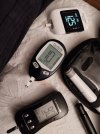I ask this after doing a test with 3 different testers all with the same droplet of blood, (Yes I managed to get a really good droplet!) and got 3 different readings of 9.0, 10.1 & 12.5.
It is confusing to get a difference of 3.5 overall and given my recent accident which is currently being deemed to be due to a hypo as my reading an hour before the accident which was taken with the Freestyle meter of 4.7, a diabetes specialist nurse giving me a stern telling off for driving with a reading below 5.0 which given the ratio of difference I would have been over that using the AccuCheck device though equally even less using the Caresens?
Obviously this serious RTA which nearly took my life has made me very curious about these matters as I really do not want to be putting me or my family at risk
It is confusing to get a difference of 3.5 overall and given my recent accident which is currently being deemed to be due to a hypo as my reading an hour before the accident which was taken with the Freestyle meter of 4.7, a diabetes specialist nurse giving me a stern telling off for driving with a reading below 5.0 which given the ratio of difference I would have been over that using the AccuCheck device though equally even less using the Caresens?
Obviously this serious RTA which nearly took my life has made me very curious about these matters as I really do not want to be putting me or my family at risk


